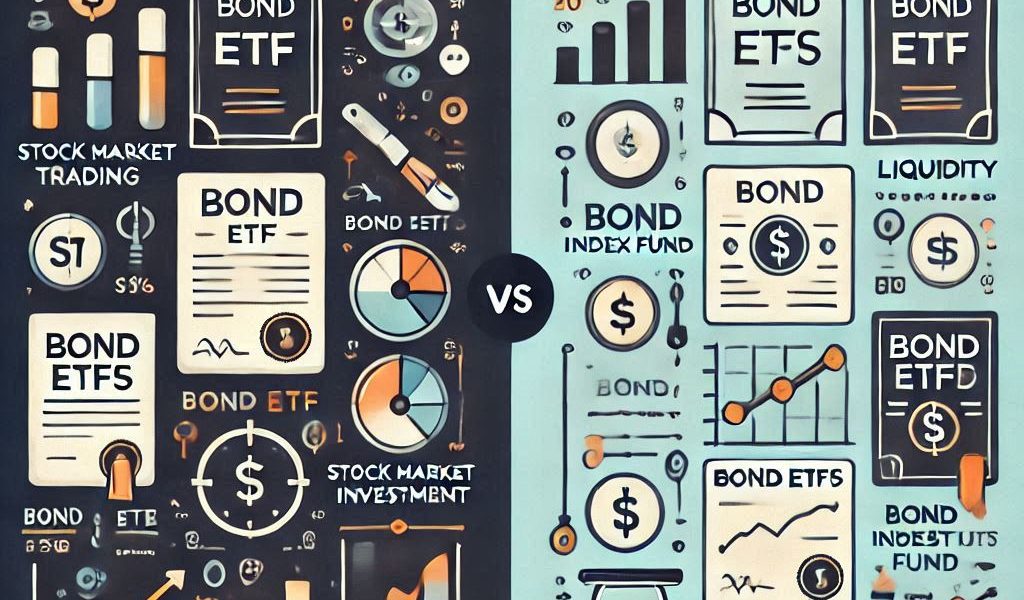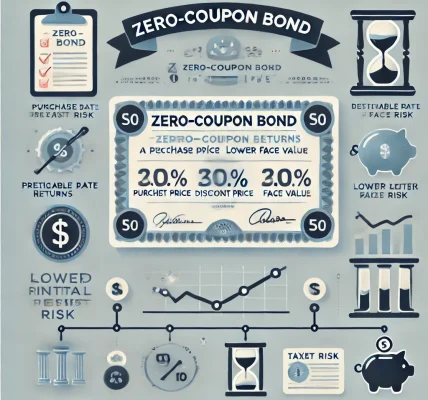Introduction:
When it comes to investing in bonds, investors have a variety of options. Two of the most popular choices are Bond Exchange-Traded Funds (ETFs) and Bond Index Funds. Both offer a way to gain exposure to a diversified bond portfolio, but they have key differences that can influence your investment strategy. This blog will break down the differences between Bond ETFs and Bond Index Funds, helping you make an informed decision based on your financial goals and preferences.
Understanding Bond ETFs:
Bond ETFs are exchange-traded funds that hold a portfolio of bonds and trade on stock exchanges, just like stocks. They are designed to provide investors with a diversified bond portfolio in a single security. Bond ETFs typically track a bond index, such as the Bloomberg Barclays US Aggregate Bond Index, but they are bought and sold throughout the trading day at market prices, similar to individual stocks.
Advantages of Bond ETFs:
- Liquidity: Bond ETFs can be bought and sold anytime during market hours, providing instant liquidity and the ability to react to market changes quickly.
- Lower Expense Ratios: Bond ETFs usually have lower expense ratios compared to actively managed funds, which can make them a cost-effective option for long-term investors.
- Diversification: Bond ETFs allow investors to gain exposure to a broad range of bonds, including government, corporate, and municipal bonds, all within a single fund.
- Tax Efficiency: Bond ETFs tend to be more tax-efficient than mutual funds because of the “in-kind” creation and redemption process, which minimizes capital gains distributions.
Disadvantages of Bond ETFs:
- Market Risk: The value of Bond ETFs can fluctuate based on changes in interest rates or bond market conditions, as they are traded like stocks.
- Trading Costs: While Bond ETFs generally have lower expense ratios, frequent trading can incur transaction costs, which can add up over time.
- Dividend Yield Variability: The dividend yield from a Bond ETF can change as the bonds within the ETF mature or are replaced, potentially leading to inconsistent income.
Understanding Bond Index Funds:
Bond Index Funds are mutual funds that aim to replicate the performance of a specific bond index. They hold a collection of bonds designed to track a particular benchmark, such as the Vanguard Total Bond Market Index Fund. Unlike Bond ETFs, Bond Index Funds are bought and sold at the end of the trading day at the fund’s net asset value (NAV), and they do not trade on exchanges throughout the day.
Advantages of Bond Index Funds:
- Set-and-Forget Investment: Bond Index Funds are a great choice for long-term investors looking for a passive investment strategy. Once invested, you don’t need to actively monitor or trade the fund.
- Stable Income: Since Bond Index Funds are designed to replicate a specific index, the income generated by the fund tends to be stable, providing a consistent cash flow for income-seeking investors.
- No Trading Fees: Unlike Bond ETFs, which may involve commission fees or other transaction costs when buying and selling shares, Bond Index Funds are typically commission-free, making them ideal for investors who want to avoid trading costs.
- Automatic Reinvestment: Many Bond Index Funds offer automatic dividend reinvestment, which allows investors to compound their returns by reinvesting interest payments.
Disadvantages of Bond Index Funds:
- Lack of Liquidity: Bond Index Funds do not trade on the exchange, meaning investors can only buy or sell at the end of the trading day at the NAV, which can limit liquidity.
- Higher Minimum Investment: Some Bond Index Funds have minimum investment requirements, which may not be suitable for smaller investors.
- Higher Expense Ratios: Although Bond Index Funds typically have low expense ratios, they may still be slightly higher than Bond ETFs due to management fees, especially in actively managed funds.
Key Differences Between Bond ETFs and Bond Index Funds:
| Aspect | Bond ETFs | Bond Index Funds |
|---|---|---|
| Liquidity | Traded on stock exchanges, can be bought/sold anytime during market hours | Only bought/sold at the end of the day at NAV |
| Trading Costs | May incur transaction fees for buying/selling | No trading fees, typically commission-free |
| Expense Ratios | Generally lower | Typically higher than ETFs, but still low |
| Income Distribution | Paid periodically, may vary | Paid periodically, usually stable |
| Tax Efficiency | More tax-efficient due to “in-kind” process | Less tax-efficient compared to ETFs |
| Investment Style | Passive, but actively traded | Passive, long-term hold |
Which One Should You Choose?
The choice between Bond ETFs and Bond Index Funds depends on your investment goals, risk tolerance, and preferences.
- Choose Bond ETFs if:
- You prefer flexibility and liquidity.
- You are comfortable with potential market fluctuations.
- You want a cost-effective option with lower expense ratios.
- Choose Bond Index Funds if:
- You are looking for a more passive, long-term investment strategy.
- You prefer stable income and do not mind limited liquidity.
- You want to avoid frequent trading and associated costs.
Conclusion:
Both Bond ETFs and Bond Index Funds offer unique benefits, and choosing the right option for you will depend on your specific investment needs. Whether you’re a beginner or a seasoned investor, understanding the differences and evaluating your financial goals will help you make an informed decision. Remember, regardless of your choice, both options provide a way to gain exposure to the bond market, which can help diversify your portfolio and protect against market volatility.



